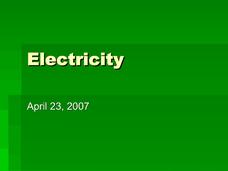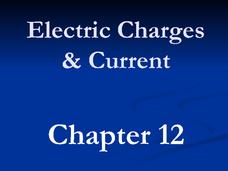Curated OER
Chemistry
As the title implies, this PowerPoint defines and illustrates the basic terms involved with describing matter. Phases of matter, atomic structure, and the different categories of compounds are included. Slides are simple and uncluttered....
Curated OER
Properties of Water
Biology and chemistry learners alike will benefit from this presentation about the properties of water. It reveals that most of its unique characteristics are due to the hydrogen bonding within the water molecule. Attractive graphics...
Mr. E. Science
The Earth in Space
Do you think Earth makes fun of other planets for having no life? The presentation covers the rotation and revolution of both the earth and our moon. It provides explanations for seasons, tides, and eclipses. Lesson is the 20th in a...
Mr. E. Science
Magnetism and Electromagnetism
The biggest magnet in the world is at the Los Alamos National Laboratory in New Mexico and can reach 100 tesla. By comparison, magnets that lift cars are about two tesla. The 11th presentation in this series covers magnetism,...
Curated OER
Happy Lesson: The Earth's Crust
This PowerPoint provides a multiple choice and fill-in-the-blank format for reviewing vocabulary and related content following an "earth's crust" science unit. The information is concise and age-appropriate and the font and colors are...
Curated OER
Nature's Perfect Recycler
What a great way to start a recycling lesson! Introduce your students to the dung beetle! They will get a kick out of "nature's perfect recycler," when they learn about the scarab beetle's way of life: eating dung and rotting...
Mr. E. Science
Forces in Fluids
Buoyancy is the fine line between a ship and a submarine. The presentation covers fluid pressure, air pressure, Pascal's Principle, elevation, Archimedes Principle, buoyancy, and Bernoulli's Principle.
Biology Junction
Echinoderms
Turn a walk on the beach into an in-depth biology lesson! Scholars learn about the different classes of echinoderms in an informative PowerPoint presentation. The lesson explains the unique characteristics of the five different...
Curated OER
Velocity and Acceleration
Compliment your physics lesson with this PowerPoint which demonstrates many important points regarding acceleration and velocity. A starter experiment activity to stimulate student thinking is given, and may prove very interesting to a...
Curated OER
Naming Covalent Bonds
Naming covalent compounds is an important topic to cover completely. This PowerPoint will support your lesson by giving numerous slides with the important prefixes, suffixes, and relevant rules. You will also find a selection of...
Curated OER
Significant Figures in Calculations
Significant figures estimate the precision of your calculations. Teach your high school scientists how to count and identify significant figures at the beginning of the school year so that they are adept at using them in their...
Curated OER
Types of Chemical Reactions
This PowerPoint presentation is sure to support your lesson on chemical reactions. Colorful diagrams and pictures, solubility tables and rules, clever animations and diagrams make teaching these concepts a cinch! Your chemistry...
Biology Junction
Annelids: The Segmented Worms
Here's a lesson that just might make your class squirm! Learn about segmented worms in a detailed PowerPoint presentation including the wriggly earthworms young scientists dig up in their backyards. Although seemingly simple creatures,...
Curated OER
Boyle's Law
After viewing this PowerPoint, physical science learners will be able to apply Boyle's law. Background information, reasoning, and data will help in understanding the behavior of gases. There are a few slides that require pupils to...
Curated OER
Nuclear Magnetic Resonance
Eleven slides are used in this PowerPoint to present how nuclear magnetic resonance works and to give learners an opportunity to interpret examples of nuclear magnetic resonance spectra. Ample information is provided, so this is a...
Curated OER
Electricity
Give your science lesson a charge with this presentation on electricity. Each slide contains vocabulary or great information on what electricity is and how it works. Note: This resource would be even better if accompanied by a video and...
Curated OER
The Work of Waves and Wind
This is not revolutionary, but it is informative. Earth science viewers in grades 7-12 get carried away with wave and wind erosion. They view diagrams of how waves impact ocean shorelines. They see examples of the different types of sand...
Curated OER
Summer Breeze
Introduce a lesson on wind with this short poem titled, "Summer Breeze." After reading the poem, ask your class why wind is important for our environment. What a great resource for a lesson hook!
Curated OER
Electricity
The presentation begins with a circuit building activity and two data tables for young scientists to copy and complete. Full of clever animations, it will definitely spark student interest! However, the information is incoherent. You may...
Curated OER
Group 7 - The Halogens
Properties and uses of the halogen elements are illuminated by this compact collection of slides. Examples of halogen reactions with alkali metals, hydrogen, and water are also explained. This is a nifty resource to support an...
Curated OER
My New Pet
Young children love talking about their pets. This presentation has learners answer a series of questions about their pets. It would be a great way to kick off a lesson on pets, animals, and pet care. After addressing the series of...
Curated OER
Weather
Intended for use with the very littlest of learners, this presentation provides the opportunity to identify various types of weather. An image of sun, rain, snow, wind, storm, and clouds are shown directly under their associated word....
Mr. E. Science
Electric Charges and Current
Resistance is not futile, it is voltage divided by current. The presentation goes in depth covering electric charges, conductors, insulators, electric fields, static charges, and circuits. The lesson is the 12th in a series of 26.
Mr. E. Science
Light
Where does bad light end up? In a prism! The presentation covers light, mirrors, lenses, and the structure of the eye. It also provides explanations of reflection, refraction, concave and convex mirrors and lenses, and a comparison of...

























